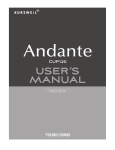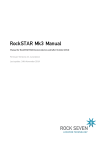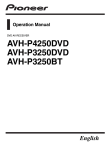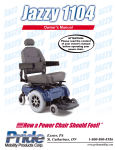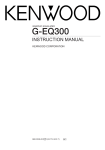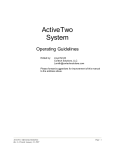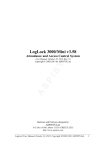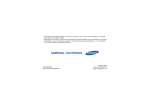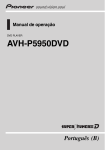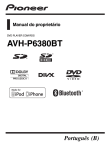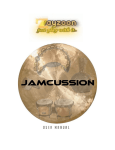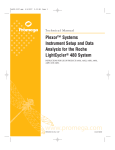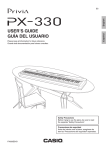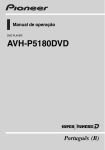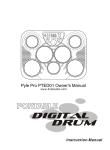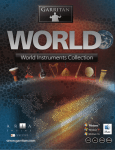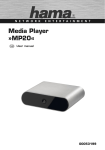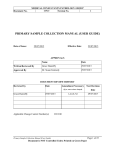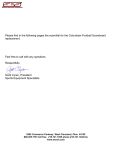Download mp20 overview
Transcript
®
IMPORTANT SAFETY INSTRUCTIONS
1.
2.
3.
4.
5.
6.
7.
Read these instructions.
Keep these instructions.
Heed all warnings.
Follow all instructions.
Do not use this apparatus near water.
Clean only with dry cloth.
Do not block any of the ventilation openings. Install in accordance with the manufacturer s
instructions.
8. Do not install near any heat sources such as radiators, heat registers, stoves, or other
apparatus (including amplifiers) that produce heat.
9. Do not defeat the safety purpose of the polarized or grounding-type plug. A polarized plug
has two blades with one wider than the other. A grounding type plug has two blades and a
third grounding prong. The wide blade or the third prong is provided for your safety. If the
provided plug does not fit into your outlet, consult an electrician for replacement of the
obsolete outlet.
10. Protect the power cord from being walked on or pinched, particularly at plugs, convenience
receptacles, and the point where they exit from the apparatus.
11. Only use attachments/accessories specified by the manufacturer.
12. Use only with a cart, stand, tripod, bracket, or table specified by the
manufacturer, or sold with the apparatus. When a cart is used, use
caution when moving the cart/apparatus combination to avoid injury
from tip-over.
13. Unplug this apparatus during lightning storms or when unused for
long periods of time.
14. Refer all servicing to qualified service personnel. Servicing is required when the apparatus
has been damaged in any way, such as power-supply cord or plug is damaged, liquid has
been spilled or objects have fallen into the apparatus, the apparatus has been exposed to
rain or moisture, does not operate normally, or has been dropped.
15. Allow adequate ventilation for the power adapter. Do not hide it under a carpet or behind a
curtain or place it in an enclosed space where heat buildup can occur.
WARNING:
To reduce the risk of fire or electric shock, do not expose this apparatus to rain
or moisture.
Do not expose this equipment to dripping or splashing and ensure that no
objects filled with liquids, such as vases, are placed on the equipment.
To completely disconnect this equipment from the AC Mains, disconnect the
power supply cord plug from the AC receptacle.
©2012 Young Chang Co., Ltd. All rights reserved. Kurzweil® is a product line of Young Chang Co., Ltd. Kurzweil®, Young Chang® , V.A.S.T.® , MP20™ are trademarks of Young Chang Co., Ltd. All other tradmarks and
copyrights are proerty of their respective companies. Product features and specificiations are subject to change
without notice.
CAUTION
RISK OF ELECTRIC SHOCK
DO NOT OPEN
CAUTION: TO REDUCE THE RISK OF ELECTRIC SHOCK,
DO NOT REMOVE THE COVER.
NO USER SERVICEABLE PARTS INSIDE.
REFER SERVICING TO QUALIFIED SERVICE PERSONNEL.
The lightning flash with the arrowhead symbol, within an equilateral
triangle is intended to alert the user to the presence of uninsulated
"dangerous voltage" within the product's enclosure that may be of
sufficient magnitude to constitute a risk of electric shock to persons.
The exclamation point within an equilateral triangle is intended
to alert the user to the presence of important operating and
maintenance (servicing) instructions in the literature
accompanying the product.
IMPORTANT SAFETY & INSTALLATION INSTRUCTIONS
INSTRUCTIONS PERTAINING TO THE RISK OF FIRE, ELECTRIC SHOCK, OR INJURY TO PERSONS
WARNING: When using electric products, basic precautions should always
be followed, including the following:
1. Read all of the Safety and Installation Instructions and Explanation of
Graphic Symbols before using the product.
2. Do not use this product near water - for example, near a bathtub,
washbowl, kitchen sink, in a wet basement, or near a swimming pool, or
the like.
3. This product should only be used with a stand or cart that is
recommended by the manufacturer.
4. This product, either alone or in combination with an amplifier and
speakers or headphones, may be capable of producing sound levels
that could cause permanent hearing loss. Do not operate for a long
period of time at a high volume level or at a level that is uncomfortable.
If you experience any hearing loss or ringing in the ears, you should
consult an audiologist.
5. This product should be located so that its location or position does not
interfere with its proper ventilation.
6. This product should be located away from heat sources such as
radiators, heat registers, or other products that produce heat.
7. This product should be connected to a power supply only of the type
described in the operating instructions or as marked on the product.
8. This product may be equipped with a polarized line plug (one blade
wider than the other). This is a safety feature. If you are unable to insert
the plug into the outlet, contact an electrician to replace your obsolete
outlet. Do not defeat the safety purpose of the plug.
9. The power supply cord of the product should be unplugged from the
outlet when left unused for a long period of time. When unplugging the
power supply cord, do not pull on the cord, but grasp it by the plug.
10. Care should be taken so that objects do not fall and liquids are not
spilled into the enclosure through openings.
11. The product should be serviced by qualified service personnel when:
A. The power supply cord or the plug has been damaged;
B. Objects have fallen, or liquid has been spilled into the product;
C. The product has been exposed to rain;
D. The product does not appear to be operating normally or exhibits a
marked change in performance;
E. The product has been dropped, or the enclosure damaged.
12. Do not attempt to service the product beyond that described in the user
maintenance instructions. All other servicing should be referred to
qualified service personnel.
13. WARNING: Do not place objects on the product s power supply cord, or
place the product in a position where anyone could trip over, walk on, or
roll anything over cords of any type. Do not allow the product to rest on
or be installed over cords of any type. Improper installations of this type
create the possibility of a fire hazard and/or personal injury.
RADIO AND TELEVISION INTERFERENCE
WARNING: Changes or modifications to the instrument not expressly
approved by Kurzweil could void your authority to operate the instrument.
IMPORTANT: When connecting this product to accessories and/or other
equipment use only high quality shielded cables.
NOTE: This instrument has been tested and found to comply with the limits
for a Class B digital device, pursuant to Part 15 of the FCC Rules. These
limits are designed to provide reasonable protection against harmful
interference in a residential installation. This instrument generates, uses, and
can radiate radio frequency energy and, if not installed and used in
accordance with the instructions, may cause harmful interference to radio
communications. However, there is no guarantee that interference will not
occur in a particular installation. If this instrument does cause harmful
interference to radio or television reception, which can be determined by
turning the instrument off and on, the user is encouraged to try to correct the
interference by one or more of the following measures:
Reorient or relocate the receiving antenna.
Increase the separation between the instrument and the receiver.
Connect the instrument into an outlet on a circuit other than the one to
which the receiver is connected.
If necessary consult your dealer or an experienced radio/television
technician for additional suggestions.
The normal function of this product may be disturbed by strong electro
magnetic interference. If so, simply reset the product to resume normal
operation by following the instruction manual. In case the function could not
resume, please use the product in another location.
NOTICE: This apparatus does not exceed the Class B limits for radio noise
emissions from digital apparatus set out in the Radio Interference
Regulations of the Canadian Department of Communications.
AVIS: Le present appareil numerique n emet pas de bruits radioelectriques
depassant les limites applicables aux appareils numeriques de la class B
prescrites dans le Reglement sur le brouillage radioelectrique edicte par le
ministere des Communications du Canada.
SAVE THESE INSTRUCTIONS
TABLE OF CONTENTS
Table of Contents
Chapter 1 Introduction
Primary Features .................................................................................................. 7
Chapter 2 Getting Started
Setting Up the MP20 ............................................................................................ 8
Volume...................................................................................................... 8
Connecting the Power Supply......................................................................... 9
Assembling the Stand ............................................................................. 10 -11
Quick Start.......................................................................................................... 12
Chapter 3 MP 20 Overview
Front Panel ......................................................................................................... 13
Front Panel Display, Buttons and Controls ................................................... 14
Display and Navigation Buttons .............................................................. 14
Voice, Rhythm, and Piano Buttons.......................................................... 15
Bank LEDs and Category Buttons........................................................... 15
Favorites and Demo Buttons................................................................... 15
Recording and Play/Stop Buttons ........................................................... 16
Variation and Tempo Buttons.................................................................. 16
Mode and Save Buttons.......................................................................... 16
Volume Control ....................................................................................... 16
Rear Panel.......................................................................................................... 17
Front Panel Buttons............................................................................................ 18
Single Buttons............................................................................................... 18
Double Button Presses ................................................................................. 18
Press and Hold Buttons ................................................................................ 18
Quick Parameter Buttons.............................................................................. 19
Operating Modes ................................................................................................ 19
Chapter 4 Demo Mode
Demo Mode........................................................................................................ 20
Playing Demo Songs .................................................................................... 20
Selecting Demo Songs ................................................................................. 20
Demo Song List .................................................................................................. 21
Chapter 5 Voice Mode
Voice Mode......................................................................................................... 22
Selecting Voices ........................................................................................... 23
Changing the Default Voice .................................................................... 23
Storing a Favorite Voice.......................................................................... 23
TABLE OF CONTENTS
Chapter 6 Layering
Layer Mode......................................................................................................... 24
Layer Mode Navigation Buttons.................................................................... 24
Selecting a Layered Voice ............................................................................ 25
Layer Mode Parameters ............................................................................... 25
Layer Volume .......................................................................................... 26
Layer Transposition................................................................................. 26
Saving Layered Voices ................................................................................. 27
Save Button ............................................................................................ 27
Favorites Buttons .................................................................................... 27
Changing Layered Voices............................................................................. 27
Chapter 7 Splitting
Split Mode........................................................................................................... 28
Split Mode Navigation Buttons...................................................................... 28
Selecting a Voice .......................................................................................... 29
Split Mode Parameters ................................................................................. 29
Split Voice ............................................................................................... 30
Split Key .................................................................................................. 30
Split Volume ............................................................................................ 31
Split Transposition................................................................................... 31
Saving Split Voices ....................................................................................... 31
Save button ............................................................................................. 31
Favorite button ........................................................................................ 31
Changing Split Voices................................................................................... 31
Chapter 8 Function Mode
Function Mode.................................................................................................... 32
Function Mode Parameters........................................................................... 32
Transpose ............................................................................................... 32
Effect Level ............................................................................................. 32
Touch ...................................................................................................... 33
Tune........................................................................................................ 33
MIDI Channel .......................................................................................... 33
Metronome .............................................................................................. 34
Rec Rhythm ............................................................................................ 34
Local Control ........................................................................................... 34
Hard Reset .............................................................................................. 34
OS/Objects Version................................................................................. 34
TABLE OF CONTENTS
Table of Contents
Chapter 9 Rhythm Mode
Rhythm Mode ..................................................................................................... 35
Entering Rhythm Mode ................................................................................. 35
Selecting a Rhythm Pattern .......................................................................... 35
Changing the Default Rhythm Pattern..................................................... 36
Playing a Rhythm Pattern ............................................................................. 35
Changing the Tempo............................................................................... 36
Rhythm Mode Parameters ............................................................................ 37
Rhythm ID ............................................................................................... 37
Volume.................................................................................................... 37
Chapter 10 Recording
Recording a Song............................................................................................... 38
Preparing to Record...................................................................................... 38
Recording Track 1................................................................................... 38
Recording Track 2................................................................................... 39
Editing a Song .............................................................................................. 39
Erasing/Recording over Tracks ............................................................... 39
Punch-Ins ................................................................................................ 39
Chapter 11 MIDI
MIDI Channels .............................................................................................. 40
MIDI In and Out Ports ................................................................................... 40
USB MIDI Connection................................................................................... 41
Appendices
MIDI Implementation Chart................................................................................. 42
Rhythm Patterns................................................................................................. 43
Voice List ............................................................................................................ 44
MP20 Features ............................................................................................... 46
Chapter 1
INTRODUCTION
Congratulations on your purchase of the Kurzweil MP20.
You are certain to enjoy many hours exploring the variety of features as well as the beautiful preset voices.
The MP20 is designed with the same sound technology from the world acclaimed PC3 Series key
board.
Primary Features
■ 88-Note, Fully-Weighted, Graded Hammer-Action Keyboard
■ 200 Preset Voices
■ 100 Preset Rhythm Patterns
■ 10 Drum Kits
■ Scrolling alphanumeric LED display
■ Layering, Split, Transpose, Pitch Tuning
■ Variation, Metronome, and Tempo buttons
■ 6 user “Favorites” presets
■ 10 levels of keyboard sensitivity
■ Two track recording with 20 User song presets
■ Dedicated button to select the Grand Piano voice
■ Preset Effects including Reverb, Echo, Delay, and Chorus
■ 51 Built In Demo Songs & Voice Demo feature
■ Stereo Audio Input and Output Jacks
■ 2 Headphone jacks
■ Standard MIDI In and Out
■ USB “Plug & Play” Computer port
■ MIDI file compatibility
■ Matching Bench Included
7
Chapter 2
Getting Started
Setting Up the MP20
Your new MP20 carton should have the following:
• MP20 instrument
• DC Power Adapter and AC cord
• Piano Bench
• MP20 Stand in Separate Box
• Warranty Card
• MP20 User’s Manual (this manual)
If you are missing any of the above, please contact your Kurzweil dealer. It is always a good idea to save the MP20 cartons, in case you need to ship it.
Before you connect cables and turn on the power, place the MP20 on a stable surface.
Follow the procedure on pages 10-11 for assembly
Volume
Before turning on the MP20, it’s always a good idea to set the volume at its minimum
setting (all the way to the left).
For a generally comfortable level of volume while playing, set the knob at its middle
position.
The Volume Control is located on the left side of the control panel. Turn this knob from
left to right to control the volume.
8
Chapter 2
Getting Started
Connecting the Power Supply
A DC power adapter supplies the MP20’s power. Before connecting the MP20’s power adapter, make sure that the power switch (located on the bottom left corner of the instrument) is in the off position.
Connect the power adapter to the DC jack on the rear panel of the MP20.
DC 19V.
3.42A
Then connect the power cord to an AC outlet.
CAUTION: All DC power adapters are NOT the same!
Only use the DC power adapter supplied with the MP20. Connecting the wrong DC power adapter could damage the MP20.
If the power adapter is damaged or lost, contact your Kurzweil Dealer to order a replacement.
9
Chapter 2
Getting Started
Assembly Instructions for MP20
X4
STEP 1: Figure 1.
X4
A) Place left leg #2 on a carpeted floor. B) Place speaker box assembly #5 and align
with holes and (4) screws #7, on top and bottom of
speaker box and tighten. (Be sure that the portholes
on bottom speaker assembly box are facing down &
speakers are facing the front. C) Place pedal cross
pedal assembly #4, with pedals facing forward. Align
with holes on bottom leg leg #2 and (2) screws #9 and
tighten. The bottom portion of the piano will now be
secure and on its side.
STEP 1
10
X4
X2
STEP 2:
Figure 2. A) Place right leg #3 &
align with holes on top and bottom of speaker
box with (4) # 7 screws. B) Align right leg bottom with cross pedal holes and attach with (2)
#9 screws. Be sure to tighten all screws. C)
The stand should now be secure and can be
taken off its side and stood straight up with its
legs.
STEP 2
Chapter 2
Getting Started
Assembly Instructions -- MP20 (continued)
STEP 3:
Figure 3. Be sure to have 2 people when lifting Main Piano Assembly.
A) Place main piano unit facing forward on top of stand and tighten with 4 Turning
bolts #8. B) Align 2 screws #10 (1 on each side) and attach from underneath to
secure leg to top unit. C) Attach headphone holder #6 with supplied screws on the
bottom of the piano. Align with holes and tighten.
STEP 3
WARNING: THE BODY ASSEMBLY WILL NOT SAFELY SIT UNSUPPORTED
ON THE LEGS UNTIL ALL OF THE SCREWS ARE IN PLACE. HAVE SOMEONE
HOLD THE BODY ASSEMBLY WHILE THE SCREWS ARE BEING SECURED.
11
Chapter 2
Getting Started
After the MP20 is set up and the power adapter connected, press the power switch. This is located on the left bottom side of the piano. While the unit is performing its power-up routine, the LED display and some of the button LEDs flash. After a couple of seconds, the display scrolls 1 Grand Piano. The MP20 is now ready to play. Use the following Quick Start for the basic steps to change Voices, play Rhythm Patterns, and play one of the 51 Demo Songs.
Quick Start
Playing the Voices
Playing a Rhythm Pattern
12
1. Turn on the power.
2. The [Voice] button LED is lit and the first voice (1 Grand Piano) is ready to play.
3. To play another voice, press any category button and play.
4. There are a number of different voices available under each category button. Press the [Prev-] or [+Next] button to step through the available voices.
5. There are two Voice Bank rows and an LED at the beginning of each row that, when lit, tells you it is the active row. To select a voice from a category listed in the second Voice Bank row, press the [Voice] button.
6. The LED at the beginning of the second row should be lit.
7. Select a category button and play.
8. Press the [Voice] button again to return to the top row.
1. Press the [Rhythm] button.
2. Select a Rhythm Pattern from one of the categories and press its button.
3. There are a number of different rhythm patterns available under each category button. Press the [Prev-] or [+Next] button to step through the available rhythm patterns.
4. Press the [Play/Stop] button, located on the top left side, to start the rhythm.
5. Press the [Play/Stop] button again to stop it.
Playing a Demo Song
1. Press the [Demo] button.
2. The first demo song immediately plays. The MP20 continues to play each of the 51 demo songs until you press the [Play/Stop], [Demo] or [Voice] buttons.
3. At any time you can press the [Play/Stop] button to start or stop playing a demo song.
4. Press the [Prev-] or [+Next] button to play the previous or next demo song.
5. Simultaneously press the [Prev-] and [+Next] buttons to jump ahead 10 songs at a time.
6. Press the [Voice] button to exit Demo Mode.
Chapter 3
MP20 OVERVIEW
Front Panel
Power Switch
Headphone Jacks
As shown in the illustration below, the power switch is located at the bottom left side of the MP20. Turn the power on and off by pressing the rocker-style switch.
The MP20 has two 1/4” headphone jacks conveniently located on the left bottom edge of the keyboard
cabinet. Plugging in headphones provides privacy during practice. Both jacks operate the same so two
people can play and hear the music together. While using headphones, the MP20’s speakers are silent.
HEADPHONE JACKS
POWER SWITCH
13
Chapter 3
MP20 OVERVIEW
Front Panel Display, Buttons and Controls
Here is a quick overview of the MP20’s front panel. A description of its individual features follows.
Display and Navigation Buttons
Display
Select ▲ and ▼ Buttons
Use these buttons to move through the list of available
parameters for the current mode. These buttons are
used in Function, Split, Layer, and Rhythm Modes only.
Prev (-) Button
Next (+) Button
14
Scrolling alphanumeric LED display.
Press this button to select the next lower Voice, Rhythm Pattern, user song or parameter value. When using the metronome or playing a Rhythm pattern, use this button to decrease the tempo. This button is also used to tune or transpose downward.
Press this button to select the next higher Voice, Rhythm Pattern, user song or parameter value. When using the metronome or playing a Rhythm Pattern, use this button to increase the tempo.
This button is also used to tune or transpose upward.
Chapter 3
MP20 OVERVIEW
Voice, Rhythm, and Piano Buttons
Voice Button
Press this button to enter Voice mode.
Rhythm Button
Press this button to enter Rhythm mode.
Piano Button
No matter what mode is active, select this button to immediately
return to the Grand Piano voice (the first voice of the Piano category).
Bank LEDs and Category Buttons
These three LEDs are indicators for the three category banks (two voice and one rhythm). Press the [Voice] or [Rhythm] button to select a bank. A lit LED indicates the active bank.
Category Buttons
Press one of the category buttons to select a voice or rhythm pattern.
Favorites Button
Bank LEDs
Favorites 1 through 6
Select one of 6 previously stored favorite sounds by pressing its [Favorites] button. Store the cur
rently selected sound (with its splits and layers) by pressing and holding the desired [Favorites]
button for 2 seconds.
Demo Button
Press the [Demo] button to begin playing the classical piano demonstration songs. Press Demo again to leave Demo mode.
15
Chapter 3
MP20 OVERVIEW
Recording and Play/Stop Buttons
Record Button
Press this button to begin recording.
Play/Stop Button
Track 1 and Track 2 Buttons
Select this button to play or stop recording, user songs, Rhythm Patterns, and Demos.
Use these buttons to select the track to record.
Variation and Tempo Buttons
Variation Button
Tempo Button
Press the [Variation] button to add the preset effects.
Use the [Tempo] button to adjust the tempo of the
metronome and Rhythm Patterns.
Mode and Save Buttons
Save Button
Function Button
Layer Button
Split Button
Volume Control
16
Press this button to save a user song or to save split and layered voices.
Press the [Function] button to enter Function Mode. Many additional features are found here.
Press the [Layer] button to enter Layer Mode and create 2 layered voices.
Press the [Split] button to enter Split Mode and create split voices.
Volume
Adjusts the volume of the MP20.
Chapter 3
MP20 OVERVIEW
Rear Panel
Audio In
Audio Out
MIDI In & Out
CC Pedal (Volume/Expression Pedal)
USB
DC
Use these RCA stereo jacks to connect the MP20’s internal speakers to other devices such as a digital audio player or CD player. Always turn off the MP20’s power before plugging or unplugging cables into the Audio In jacks.
Use these RCA stereo jacks to connect the MP20 to external audio equipment, such as an outboard mixer, powered speakers, or recording device.
Use the MIDI In and Out ports to connect the MP20 to other MIDI devices to receive and send MIDI data.
Use this 1/4” jack to connect a continuous controller pedal and assign it to control volume and expression.
Connect a USB cable to this port to send and receive MIDI or to connect to a computer for system updates.
Connect the DC Adapter to this jack.
17
Chapter 3
MP20 OVERVIEW
Front Panel Buttons
Single Buttons
There are 32 buttons on the MP20 Front Panel. Most buttons have LEDs that light up when the button is pressed and remain lit to show the button is active. Four buttons do not have LEDs, they are: [Select] ▲ and ▼, [Prev-], and [+Next].
Double Button Presses
Certain buttons, when pressed simultaneously with another button, have other functions. They are called button pairs. The MP20 has two button pairs: [Select Jump] and [Value Jump].
Simultaneously press the [Select] ▲ and
Value Jump
▼ buttons.
Simultaneously press the [Prev-] and [+Next] buttons.
Press and Hold Buttons
Some buttons, when held, perform additional functions. Below is a brief description of these buttons.
Category Buttons
Prev (-) and (+) Next Buttons
Favorites Buttons
18
Select Jump
In Voice or Rhythm Mode, pressing a category button selects the default or first voice for that
category. You can change the default voice or rhythm. To do so, select the voice or rhythm you want to use as the default. Press and hold the category button until the display scrolls SAVED, then the ID number. (Release the button when SAVED scrolls across the display.)
Press and hold either button and it will repeat until it is released.
Press and hold one of the six [Favorites] buttons to store the current voice, layer or split.
Chapter 3
MP20 OVERVIEW
Hard Reset
To clear all user data and return the MP20 to its default settings, you need to perform a Hard Reset.
Turn off the MP20 power. Press and hold the C8 key (highest key on the keyboard). Turn on the power switch (bottom left side of unit) while continuing to hold down the top key. As soon as you see “Resetting” scroll across the display, release the C8 key. The MP20 is now reset to factory default.
Quick Parameter Buttons
Quick parameter buttons are named as such because they are parameter buttons accessible from the front panel. The MP20 has two quick parameter buttons: [Tempo] and [Variation].
A quick parameter button can be accessed from any mode, except recording.
Tempo Quick Parameter Button
Press the [Tempo] quick parameter button to change the tempo. Use the [Prev-] or [+Next] button to decrease or increase the tempo. Press both together to restore the default tempo of 120bpm.
If no action is performed after pressing the [Tempo] button, the button will time out and the MP20 exits the Tempo quick parameter and returns to its previous state.You can also exit the Tempo quick
parameter by pressing the [Tempo] button again.
Variation Quick Parameter Button
Press the [Variation] quick parameter button to add preset effects (if any) to the current voice.
Operating Modes
Most of the MP20’s features are organized in groups called modes. The MP20 has six operating modes. The following chapters describe each of the operating modes.
■ Demo
■ Voice
■ Rhythm
■ Layer
■ Split
■ Function
19
Chapter 4
demo mode
The MP20 has 51 pre-recorded grand piano songs performed in a variety of classical styles that demonstrate
the Grand Piano Voice. You can also preview any other sound in the Voice Demo mode.
Selecting Demo Songs
1. Press the [Demo] button to enter Demo Mode. The [Demo] button is located
on the far right side of the front panel; it is the last button on the second row.
2. The first demo song, Brahms-Rhapsody, begins to play and its song number and name scrolls across the
display. When the first song ends, the next demo song
begins to play. This continues through all 51 demo songs.
Press the [Play/Stop] button to start or stop playing a demo song.
3.To step through the demo songs and select another song to play, press the [Prev-] button to select previous demo
song or the [+Next] button to select the next demo song. You may have to press the [Play/Stop] button to stop the current demo song and press the [Play/Stop] again to start the next demo song.
4. To skip forward 10 songs at a time, press the [Value Jump] buttons together.
5. Keyboard keys (A0 through B4) are assigned to each demo song. To select a demo song using a key on the keyboard, press the [Record] button then press and release its corresponding key. See the Demo Song List for the demo
songs and their corresponding keyboard keys.
6. To exit Demo Mode, press either the [Demo], [Voice] or [Piano] buttons. See the following page for a complete list
of the demo songs.
20
VOICE DEMO
The Voice Demo is a small song that shows how a particular voice sounds. This allows you to preview any sound without playing it. To activiate the voice demo, follow these steps:
1. Select “Voice” mode and choose your category for sounds.
2. Scroll using [+Next] and [Previous -] buttons. Then select the voice to preview or demo.
3. Press and hold the [Demo] button for 3 seconds. The chosen voice will play the demo song. The Voice
demo will stop, once it reaches the end of the song.
4 To stop the demo at any time, press the [Stop] button. (You can also select the Piano button or any other
category button to stop the demo).
5. To switch to another voice demo, simply repeat these steps.
Chapter 4
DEMO SONG LIST
demo mode
DEMO SONG LIST
No.
1
2
3
4
5
6
7
8
9
10
11
12
13
14
15
16
17
18
19
20
21
22
23
24
25
26
27
28
29
30
31
32
33
34
35
36
37
38
39
40
41
42
43
44
45
46
47
48
49
50
51
Song Name
Rhapsody
Prelude I
Invention No. 4
Invention No. 8
Prelude II
Aria Goldberg
Fuga II
Sonatine Op.36
Piano Sonate
Rondo in D
Piano Sonate K.3
Piano Sonate K.5
Minuet in G
Bagatelle No. 25
Sonatine Op.55
March Militaire
Moments Musicaux
Impromptu No. 2
Impromptu No. 4
La Chevaleresque
Without words
Venetianisches
Sostenuto
Valse KK
5 Mazurkas
Valse Op.69 No. 2
Grande Valse
Valse Op.64 No. 2
Nocturne No. 2
Valse Op.64 No. 1
Preludes in Db
Fantaisie-Improm
Dolly s Dreaming
stimmen
The Swan
Blumenlied
Valsette
Old French Air
Mazurka
Polka
Barcarolle
Humoreska
Suite Peer Gynt
Suite Bergamasque
Rêverie
Arabesque I
Key
A0
A#0
B0
C1
C#1
D1
D#1
E1
F1
F#1
G1
G#1
A1
A#1
B1
C2
C#2
D2
D#2
E2
F2
F#2
G2
G#2
A2
A#2
B2
C3
C#3
D3
D#3
E3
F3
F#3
G3
G#3
A3
A#3
B3
C4
C#4
D4
D#4
E4
F4
F#4
G4
G#4
A4
A#4
B4
Composer
J. Brahms
J. S. Bach
J. S. Bach
J. S. Bach
J. S. Bach
J. S. Bach
J. S. Bach
M. Clementi
W. A. Mozart
W. A. Mozart
W. A. Mozart
W. A. Mozart
W. A. Mozart
L. V. Beethoven
L. V. Beethoven
Fr. Kuhlau
F. P. Schubert
F. P. Schubert
F. P. Schubert
F. P. Schubert
ler
J. L. F. Mendelssohn
J. L. F. Mendelssohn
F. F. Chopin
F. F. Chopin
F. F. Chopin
F. F. Chopin
F. F. Chopin
F. F. Chopin
F. F. Chopin
F. F. Chopin
F. F. Chopin
F. F. Chopin
R. Schumann
R. Schumann
R. Schumann
F. Liszt
T. Oesten
J. Strauss
SaintG. Lange
F. Borowski
P. I. Tchaikovsky
P. I. Tchaikovsky
P. I. Tchaikovsky
P. I. Tchaikovsky
A. Dvorak
E. Grieg
C. A. Debussy
C. A. Debussy
C. A. Debussy
21
Chapter 5
VOICE MODE
When you turn on the MP20, Voice Mode is active and the Grand Piano voice is already selected and ready to play.
Grand Piano is the default voice and the first voice in the Piano category.
In Voice Mode, voices are selected first by choosing one of two Voice Banks, then a category.
There are two rows of Voice Bank categories and one row of Voice Bank buttons. Categories generally group instruments by type.
To the left of each Voice Bank category row is an LED. A lit LED indicates the active Voice Bank. To select the second Voice Bank row, press the [Voice] button again. Its LED lights and the second row of categories is active.
22
Chapter 5
VOICE MODE
Selecting Voices
If the MP20 is not already in Voice Mode, press the [Voice] button, to return to your sounds.
To select another voice from the category, press the [Prev -] or [+Next] button to navigate through the available voices. If you are pressing the [+Next] button and reach the last voice of the category, the
MP20 automatically advances to the first voice of the next category. If you are pressing the [Prev-]
button and reach the first voice of the category, the MP20 automatically moves to the last voice of the previous category.
Press the [Value Jump] button (simultaneously press the [Prev -] and [+Next] buttons) to select the default or first voice of the current category. If the first voice of a category is already selected,
pressing the [Value Jump] button selects the first voice of the next category. This cycles through and wraps back to the first category.
NOTE: A complete list of the Voices by category begins on page 44.
Press the button for the category you want. Its LED lights and the default voice for that category is selected.
Changing Category Default Voices
Pressing a category button selects the default or “first” voice for that category. You can change the default voice for that category. Follow these simple steps:
In Voice mode, select the category and press the [Prev -/Next+] buttons to find your desired sound to save as your default. Press and hold the [Category] button until the display scrolls SAVED. Release the button when SAVED scrolls across the display. Your new sound is now saved as the first or default voice for that category.
Storing a Favorite Voice
You can quickly save any voice or layered sounds as a favorite. Just select a voice, or layer, then press and hold one of the six [Favorites] buttons at least 1.5 seconds. The voice is now stored in that location.
23
Chapter 6
LAYERING
In addition to the many presets already available in the MP20, you can
create layered voices and add even more depth and breadth to its rich
sounds.
Layering combines two of the MP20 voices enabling you to play both
voices together.
24
Layer Mode Navigation Buttons
Depending on the selected parameter and the current mode, some buttons operate differently. The following is a description of the Layer Mode navigation buttons.
Select▲ and ▼ Buttons
Prev (-) or (+) Next Buttons
Category Buttons
Use these buttons to step through the parameters.
For the Layer Voice parameter, use these buttons to step through the category voices. In Layer Vol
ume or Layer Transposition, use these buttons to increase or decrease a value.
In Layer Voice, use this button to select another category; it acts the same as it would in Voice Mode. If the Layer Volume or Layer Transposition parameter is active, pressing a category button returns the MP20 to the Layer Voice parameter.
Chapter 6
LAYERING
Layered Voice
Select the voice you want as your primary voice, by choosing the sound in the Category section. Scroll with the [Prev -] or [+Next] buttons to find your sound.
Press the [Layer] button to enter Layer Mode. When the [Layer] button is pressed, the current voice becomes the primary layer voice. The [Layer] button LED lights and secondary voice of the layer scrolls across the screen. (The default is 87, LA Strings). The primary voice is now layered with the seondary voice.
To exit Layer Mode, press the [Layer] button again.
Changing the Layered Voice
Press the [Layer] button to enter Layer mode.(The default voice is 87, LA Strings). To change to a new sound, the Voiice button must be ON. Choose the category you want on Row 1 or Row 2 by toggling the Voice button to either row. Select the category sound you desire. Scroll with the [Prev -] or [+Next] buttons to find your desired sound.
NOTE: The new sound chosen is now your secondary sound. When in [Layer] mode, only the secondary sound can be changed. You must start with your primary sound to create your desired combination.
Layer Mode Parameters
There are three parameters available in Layer Mode. Changing the value of a parameter determines the performance of the layer.
In Layer Mode, use the Select▲ and ▼ Buttons to step through the parameters. To change the value of parameter, press the [Prev-] or [+Next] button.
Using the parameters available in Layer Mode, you can modify or change the layered voices.
Descriptions of the Layer Mode parameters follow on page 26.
25
Chapter 6
LAYERING
Layer Voice - Volume Balance
The parameter sets the balance volume between the 2 layered sounds.
Press the [Layer] button, so you are now in Layer mode. Press the Arrow Up [Select ] button (to the left of the screen). This parameter sets the volume between the layered voices. The display scrolls VOL:0 ( 0 is the default settering). Use the {Prev -] button to decrease the volume of the left hand (secondary voice). The range will be from 0 to -9. Press the [+Next] button to increase the volume of the left hand (secondary voice). The range will be from 0 to +9. This will allow you to custom balance your two desired voices.
NOTE: Pressing the [Prev -] or [+Next] button pair together will reset the layer balance back to factory default of 0. Press and hold any of the “Favorites” buttons 1-6 to save your setting.
VOL : 0
Layer Octave Transposition
This parameter sets the transposition of the secondary voice (left hand) relative to the primary voice. In LAYER mode, press the Arrow Up [Select ] button, until you arrive at the LED screen display: XPOSE:0. To transpose the secondary voice up an octave, press the [+Next] button once.
(The screen will display 12). Press the [+Next] button twice to move up 2 octaves. (The screen will show 24). Toggle twice back to 0 for the default setting. To lower an octave, simply reverse the steps by pressing [Prev -] button to change or lower the octaves for the left hand (secondary) voice.
NOTE: Pressing the [Prev -] or [+Next] button pair together will reset the octave back to factory default of 0. Press and hold any of the [Favorites] buttons 1-6 to save your setting.
XPOSE: 0
26
Chapter 6
LAYERING
Saving Layered Voices with Favorite Buttons
Once you have created your layered sound, select a [Favorite] button 1-6 to store the layered voice. Press and hold any [Favorite] button 1-6 at least 1.5 seconds. The layered voice is now stored in that location. To Exit press the layer button again.
NOTE: if you have saved a layered voice as a favorite and want to make a change, select the favorite. Press the [Layer] button to enter Layer Mode.
Saving Layered Voices Using the “Save” Button
Once you have created your layered sound, press the [Save] button located to the left of the screen. The display now shows the first empty location in the favorite section. The display shows: “Save Voice As...F1 - F6”. Press the [Save] button again to save the layered voice.
NOTE: If you desire to save to another Favorite other than default, press the [Prev -] or [+Next] buttons to change to another Favorite location. (Continuously pressing the [Prev -] or [+Next] button cycles through all six favorite locations).
If you don’t save the current changes and exit Layer Mode, the MP20 remembers the last layered voice. Simply press the [Layer] button again and your changes should still be available to save. Be sure to save your changes before you turn off the MP20 or they will be lost.
27
Chapter 7
SPLIT MODE
Split Mode
Creating a Split allows you to divide the MP20
keyboard into an upper and lower region.
For example, you can create a split and
play Piano with the right hand and
Bass with the left hand.
Split Mode Navigation Buttons
Split
Depending on the selected parameter and the current mode, some buttons operate differently.
The following is a description of the Split Mode navigation buttons.
28
Select▲ and ▼ Buttons
Use these buttons to step through the parameters.
Prev (-) or Next (+) Buttons
For the Split Voice parameter, use these buttons to step through the category voices. In Split Key, Split Volume or Split Transposition, use these buttons to increase or decrease a value.
Category Button
In Split Voice, use this button to select another category; it acts the same as it would in Voice Mode. If the Split Key, Split Volume or Split Transition parameter is active, pressing a category button returns the MP20 to the Split Voice parameter.
Chapter 7
SPLIT MODE
Selecting Split Mode Voices
Select the voice you want to use as your primary voice. Press the [Split] button to enter Split Mode. The [Split] button is located on the left side of the front panel.
When the [Split] button is pressed, the current voice becomes the primary (right hand) split voice.
To exit Split Mode, press the [Split] button.
NOTE: The default voice ID is 183, E Bass, and the default split key is F#3
Split Mode Parameters
There are four parameters available in Split Mode:
■ Secondary or “Left Hand” Voice Split
■ Split Key Position
■ Split Volume Balance
■ Secondary or “Left Hand” Octave Change
In Split Mode, use the [Select]▲ and
▼buttons to step through the parameters.
Press the [Prev -] or [+Next] buttons to make your changes to that parameter. These functions are explained on pg. 30.
29
Chapter 7
SPLIT MODE
Split Voice Change for Secondary or Left Hand
Press the [Split] button, and the parameter is selected for the primary and the scondary voice. (The default factory split is PRG:183, E Bass.) To choose a different voice as the secondary voice, press the category voice you desire, then press the [Prev -] or [+Next] buttons to scroll to your selected sound. The new sound will now become your default “left hand”or secondary voice.
NOTE: Pressing the [Prev -] or [+Next] button pair together, will reset to the factory default voice setting. Press and hold [Favorites] buttons 1 - 6 to save your setting.
PRG: 183
Changing Split Key
In Split mode, press the Arrow Up [Select ] button until you arrive at the screen display KEY:F#3 (the factory default split). The split key is the highest key of the secondary voice. Press the [Prev -] or [+Next] buttons to change the position of the split key. Pressing the [+Next] button will take you to the next highest key. Pressing the [Prev -] button will take you down a step. You can select any split point across all 88 keys from A0 to C8.
NOTE: Pressing the [Prev -] or [+Next] button pair together will reset the F#3 factory deault split. Press and hold [Favorites] buttons 1-6 to save your setting.
KEY: F#3
30
NOTE: Changes to the Split Voice, Split Key, Split Volume, and Split Transposition are remembered for the next time you want to use a split voice; but are not stored in memory. They return to their default settings when you turn off the MP20. Be sure to save your changes as one of the Favorites!
Chapter 7
SPLIT MODE
Balance Split Volume
This parameter sets the volume between the two split sounds.
In Split mode, press the Arrow Up [Select ] button until you arrive at the screen display “VOL:0”. This is the Split Balance Volume. Press the [Prev -] button from -1 to -9 to decrease the volume of the secondary voice (left hand). Press the [+Next] button from +1 to +9 to decrease the volume for the primary voice (right hand). The value range of this parameter is -9 to +9 with 0 being the factory default balance.
NOTE: Pressing the [Prev -] or [+Next] button pair together will reset back to the factory default split
volume of 0. Press and hold [Favorites] buttons 1 -6 to save your setting.
VOL: 0
Split Octave Transposition
This parameter sets the transposition of the secondary voice relative to the primary voice.
In “Split” mode, press the Arrow Up [Select ] button, until you arrive at the LED Screen display, XPOSE:0 ST. To transpose the secondary voice up an octave, press the Next (+) button once, to move up an octave. (The screen will display 12 ST). Press the Next (+) button twice to move up 2 octaves. (The screen will show 24:ST). Toggle twice back to 0 for the default setting. To lower an octave, simply reverse the steps by pressing the Prev (-) button to change octaves for the left hand or the secondary voice.
Saving and Changing Split Voices
NOTE: Pressing the [Prev -] or [+Next] button pair together will reset the octave back to factory default to 0. .
Press and hold [Favorites] buttons 1-6 to save your setting.
There are two ways you can save a split voice along with your changes. Both are quickly executed with just a couple of button presses. The first way is to select the [Save] button and enter the Save Dialog, the second is using a [Favorites] button. To change a saved split voice, simply go back to the saved [Favorites] location and make your change.
NOTE: Changes to the Split Voice, Split Key, Split Volume, and Split Transposition are remembered for the next time you want to use a split voice; but are not stored in memory. They return to their default settings when you turn off the MP20. Be sure to save your changes as one of the Favorites!
31
Chapter 8
FUNCTION MODE
The Function Mode includes parameters that allow you to change the behavior of the entire
instrument. The following are available parameters in function mode: Transpose, Effect Level, Touch Sensitivity, Tune, MIDI Channel, Metronome, Rec Rhythm, Local Control, Hard Reset, OS/Object.
32
Press the [Function] button to enter Function mode. Pressing the up or down [Select] button will take you through the variou sparameters mentioned above. Once you arrive at a parameter, you will use the [Prev -] or [+Next] buttons to navigate the parameters of that function. Pressing the [Function] button a second time will Exit..
Transpose
The Transpose parameter allows you to adjust the overall pitch of the keyboard up or down in semitone intervals.
In Function mode, Press the the up or down [Select] button until the LED Screen displays, TRANSPOSE:0 (factory default). To transpose the pitch up, press the [+Next] button for each semitone up in pitch. To lower or transpose down, Press the [Prev -] button to lower the semitone pitch. Pressing the [Prev -] [+Next] button pair together, will reset the Transposition back to factory default of 0.The transposition has a range of -24 to +24. This offers a two octave transposition range up or down.
To save the transposition you must first
Exit the Function menu then press and
hold any of the [Favorites] buttons 1-6 to
Save your setting.
Effect Level
The Effect parameter controls the level of the reverb effects used on a voice.
In Function mode, press the “up or down [Select] button until the LED Screen displays, EFFECTS LEVEL:20 (factory default). To increase the reverb effect, “Press” the [+Next] button for your desired effect. To lower or reduce the reverb effect, Press the [Prev -] button down. You can adjust the amount of effect from 0% (no effect) to 100%. Pressing the [Prev -] [+Next] button pair together, will reset the effect level back to factory default of 20%.
To save your desired effect setting, you must first
exit the Function menu, then press and hold
any of the [Favorites] buttons 1-6 to save your
setting.
TRANSPOSE: 0
EFFECTS LEVEL
: 20
Chapter 8
FUNCTION MODE
Touch
Use this parameter to adjust the keyboard touch sensitivity to your playing technique.
In “Function” mode, press the “Select” up or down arrows until the LED Screen displays, TOUCH:LINEAR (factory default). To change the setting effect, press the [+Next] button to the next desired touch. Press the [Prev -] button down to reverse the steps. The following are the available settings:
Linear Light 1/ For players with a light touch. Adjust this parameter to achieve a good dynamic Light 2
range.These settings are from Light 1, a slightly light touch to Light 3, a very Light 3
Hard 1
Hard 2
Hard 3
Piano Touch Best for piano dynamics.
Easy Touch Light touch, especially for younger players.
GM Receive Select this when playing General MIDI songs.
Pressing the[Prev -] [+Next] button pair together, will reset the effect
level back to factory default of Linear.
Tune
This parameter allows you to adjust the tuning to.other instruments or recordings.
Best Dynamic Range for instruments (Factory Default Setting).
light touch.
For players with a heavier touch. Adjust this parameter to achieve a good dynamic range. These settings are from Hard 1, a slightly harder
touch to Hard 3, a very hard touch.
In Function mode, press the Arrow Up or Down [Select ] button until the LED Screen displays, TUNE:0
(factory default is A - 440). To increase the tuning, Press the [+Next] button from 0 to 100 cents. To lower or reduce the tuning Press the [Prev -] button from 0 to -100 cents. Pressing the [Prev -] [+Next] button pair together, will reset the effect level back to factory default of 0 or A-440.
To save your desired Tuning setting, you must first exit the
Function menu, then press and hold any of the [Favorites]
buttons 1-6 to “Save” your setting.
MIDI Channel
LINEAR
This parameter controls the MIDI transmit channel used for Voice Mode.
In Function mode, Press the up or down [Select] button arrows until the
LED Screen displays , CHANNEL: 1 (Factory Default) You can select
Channels 1 through 9 and Channels 11 through 15. Channel 10 is
reserved for rhythm playback and Channel 16 for the metronome.
Pressing the [Prev -] [+Next] button pair together, will reset the MIDI
Channel back to the factory default of 1.
(See Chapter 11, MIDI, beginning on page 40.)
TUNE: 0
CHANNEL: 1
33
Chapter 8
FUNCTION MODE
Metronome
Rec Rhythm
In “Function” mode, press the Select up or down arrows until the LED Screen displays, REC RHYTHM: OFF (factory default). To change to “On” press the [+Next] button once. Toggle back to turn back off.
To save your desired setting, you must first
exit the Function menu, then press and hold any of the
[Favorites] buttons 1-6 to save your setting.
Local Control
34
This parameter has three settings: On, Rec or Off. The default setting is “Off”, (no metronome). If you choose “On”, the metronome sounds while playing or recording. To hear the metronome only while recording, choose Rec.
In “Function” mode, Press the up or down [Select] button until the LED Screen displays, METRO: OFF
(factory default). To change to “On” “Press” the [+Next] + button once. The metronome sounds while playing or recording. To change to “Rec.”, Press the [+Next] button again. This allows you to hear the metronome only while recording. Pressing the [Prev -] [+Next] button pair together, will reset the Metronome back to “Off”
(factory default)
To save your desired Metronome setting, you must first exit the
Function menu, then “press and hold” any of the
[Favorites] buttons 1-6 to save your setting.
METRO: OFF
This parameter controls whether a rhythm pattern plays during recording. The default for this parameter is Off. If you record a song and want the rhythm pattern recorded as well, be sure to change this parameter to On.
REC Rhythm:
OFF
This parameter is normally set to “On”. When you play the MP20 keyboard you hear the resident or “local” voices. If you use your MP20 with an external sequencer or computer, turn this setting to Off. Turning the setting Off, avoids creating a MIDI loop (stuck notes or “echoes”). Use the Select Arrows [Prev -] [+Next] buttons to achieve your setting.
Hard Reset
This function resets the MP20 to the original factory default settings. All user changes, saved Favorites, and user recorded songs are erased. In “Function, press the “Select” up or down arrows until the LED Screen displays, HARD RESET ? To reset to (factory default), press the [+Next] button once. The display
now scrolls CONFIRM? Press the [+Next] button again confirm and to reset the MP20. If you want to cancel the Hard Reset and remain in Function Mode, press the [Prev -] button. Press any other button to exit
Function Mode.
OS/Objects Version
This parameter displays the current operating software and objects version. The display first scrolls the OS version, then the Object version. on. Visit the Kurzweil website (www.kurzweil.com) to verify that your MP20 has the latest versions. This is located under the Downloads tab for the MP20. Complete installation instruc
tions are included in the downloaded files. A standard USB cable will be required for this operation.
Chapter 9
Rhythm MODE
There are 100 rhythm patterns stored in the MP20. The rhythm patterns include a wide variety of musical styles. The labels directly above the category buttons list the different rhythm categories. A complete list of the available rhythm patterns begins on page 43.
Entering Rhythm Mode
Press the [Rhythm] button to enter Rhythm Mode. The [Rhythm] button’s LED lights up as well as the Rhythm Bank LED. The display shows the ID number of the current rhythm pattern.
Selecting and Playing a Rhythm Pattern
There are eight category buttons in the Rhythm Bank. The first seven buttons are for the rhythm patterns and are grouped by style. The eighth button, labeled [User], is for user recorded songs.
After you select a category, press the [Prev -] [+Next] button to scroll through the rhythm patterns.
When you reach the end of a category. , The MP20 automatically advances to the next or previous category. It will also advance to the User category. If there are no user recorded songs, it will bypass the User category and go to the next or previous category.
Once you’ve chosen your desired rhythm, press the [Play] button (on the left side) to playback your rhythm. Press the “Stop” button to Stop your rhythm. Once you select a rhythm pattern, it is remembered as the
current pattern in Voice Mode. If you save a voice as a [Favorites], the current rhythm pattern is also saved.
35
Chapter 9
RHYTHM MODE
Changing the Default Rhythm Pattern
NOTE: The default rhythm pattern is ID number 1, Ballad1.
Pressing a category button selects the default rhythm pattern for that category. You can change the default rhythm pattern. To do so, select the pattern you want for the default rhythm. Press and hold the category button until the display scrolls SAVED then shows the ID number. (Release the button when SAVED scrolls across the display.)
Changing the Tempo
You can change the tempo of the MP20’s rhythm
patterns. The default tempo is 120 BPM (beats per
minute), but it can range from 20 to 300 BPM.
To change the tempo, press the [Tempo] button. Its LED
lights and the display shows the current tempo. Press
the [Prev-] button to decrease the tempo or press the
[Next+] button to increase the tempo.
36
NOTE: To return to the default setting of 120 BPM, press the [Prev -] [+Next] buttons together. Tempo changes affect all rhythm patterns, even Favorites. To save your desired Temp setting,
press and hold any of the [Favorites] buttons 1-6 to save your setting
Chapter 9
Rhythm MODE
Rhythm Mode Parameters
The available parameters in Rhythm Mode are: Rhythm ID and Volume. Press the [Select]▲ and
button to select a Rhythm Mode parameter.
▼ Rhythm ID
The default parameter is Rhythm ID. Pressing the [Select Jump] button pair ([Select]▲ and
▼
buttons simultaneously) defaults to this parameter.
The [Value Jump] button pair (pressing the [Prev-] and [+Next] buttons simultaneously) advances to the first rhythm of the current category. If you continue to press the [Value Jump] button, you can advance to the first rhythm in each category. This cycles through and wraps back to the first category. If there are no user recorded songs, the display scrolls the song ID, U1, and EMPTY.
Volume
Use the Rhythm Mode volume parameter to change the volume of the rhythm pattern for playback or recording. The volume range is from 1 (minimum) to 9 (maximum). The default volume setting is 9 (maximum).
In Rhythm Mode, press the [Select]▲ and ▼ button. The display scrolls VOL:X (X represents the current volume setting). Press the [Prev-] and [+Next] button to increase or lower the volume.
NOTE: Changing the volume affects all rhythm patterns, even Favorites. To reset the volume to the default setting, press the [Value Jump] button pair (simultaneously press the [Prev-] and [+Next] buttons).
37
Chapter 10
RECORDING
Recording a Song
The MP20 has a two-track recorder. You can record two voice tracks and a rhythm pattern accompaniment. Favorites can be used to give you even more versatility while recording. For example, you can have a Favorite split voice such as Piano and Bass recorded in Track 1 and a layered favorite in Track 2.
Preparing to Record
If you want to have a rhythm pattern play while recording, select the [Function] button to enter Function Mode. Press the [Select]▲ and ▼ button to step through the list of parameters. The default setting for the REC RHYTHM parameter is OFF, press the [Prev-] or [+Next] button to change the value to ON.
You can leave this parameter set to ON. There is a “no rhythm” pattern available, rhythm ID number 351. Select this rhythm pattern and no rhythm will play.
NOTE: The default setting for the metronome is also OFF. Follow the instructions described above to enter Function Mode, but select the METRO:off parameter and change its setting to metro:rEC. This will allow the metronome to play during recording.
38
Recording Track 1
Select the voice you want to use for Track 1. To record a song with a rhythm pattern, press the [Rhythm] but
ton and select ct a pattern for your recording. Press the [Record] button. Its LED lights and the display scrolls RECORD READY. The [Track 1] button’s LED should also be lit.
To begin recording, press the [Play/Stop] button and start playing. When you are finished Recording, press the [Play/Stop] button again. The [Save] button’s LED starts flashing and the display shows SAVE RHYTHM AS:(U1 – U20). These represent the number of the first available empty user song locations). There are 20 available song locations.
Press the “Save” button and “Track 1” is now saved in one of the user song presets.
NOTE: If you are using the metronome, it will count off one measure before recording begins.
To change to another user preset (U1 – U20), press the the [+Next] button to advance to a different User Pre
set Number. Press the “Save” button to store that preset.
Chapter 10
RECORDING
Recording Track 2
The [Save] button’s LED is flashing and the display shows SAVE RHYTHM AS Ux (AS:(U1 – U20). Press the [Save] button and Track 2 is now saved in one of the user song presets. Simply press play to listen back to your recording. To change to another user preset U1 – U20, press the [+Next] button to advance to a different User Preset Number and Press the save button to store it. X represents the user song location number of Track 1).
Press the [Track 2] button, then the [Record] button. The display scrolls RECORD READY message. Press the [Play/Stop] button to begin recording Track 2. (Track 1 is playing while recording Track 2.) Press the [Play/Stop] button again when you are finished.
SAVE
RHYTHM AS
Editing & Finding a Song
Press the “User” Button located to the far left of the Rhythm bank. Press the [Prev-] or [+Next]+ button to scroll through the list of User Presets (U1 – U20) to find your saved song. Press the “Play” button to preview your saved song. You are now ready for editing.
Erasing / Recording over Tracks
Select the user recorded song and press the button for the track you need to erase. Press the [Play/Stop]
button, then press the [Record] button and start playing. Press the [Play/Stop] button when you are finished and press the [Save] button to save the song.
Punch-Ins
Punching in is a way to correct mistakes on a recording without re-recording the entire track.
Select the user recorded song and press the button for the track you need to change. Press the [Play/Stop] button. Your song begins to play. When it reaches the part you need to correct, press the [Record] button and play the note(s) you need to punch-in the recording. After the punch-in, press the [Play/Stop] button. If you don’t press the [Play/Stop] button after you Punch-In, you will erase the remaining portion of the track.
39
Chapter 11
MIDI
MIDI is the acronym for Musical Instrument Digital Interface. It is the industry standard protocol that allows the exchange of musical data between electronic musical instruments, devices (such as
sequencer), and computers. MIDI enables MIDI equipped devices designed by different manufacturers the ability to communicate MIDI data to each other.
MIDI data is sent or received using standard MIDI cables to connect to other MIDI devices or a USB cable to connect to a computer.
The MP20 is equipped with conventional MIDI In and Out ports and a USB port.
MIDI Channels
Similar to television channels, MIDI protocol transmits multiple channels of MIDI performance data. Typical MIDI instruments can play up to 16 channels at the same time. Each channel can be assigned its own voice.
To change and/or assign MIDI channels, enter Function Mode and select the MIDI Channel parameter. See page 33 for the details.
MIDI In and Out Ports
The MP20 is equipped with the conventional MIDI In and MIDI Out ports. If you are new to MIDI, the MIDI In port is used to receive MIDI data from another MIDI device; and the MIDI Out port is used to transmit MIDI data to another MIDI device.
When you connect the MIDI Out of the MP20 to the MIDI In of another instrument, you can play the sounds of both instruments simultaneously from the MP20 piano.
40
When you connect the MIDI In of the MP20 to the MIDI Out of another controller, you can control the MP20 using the other controller.
Chapter 11
MIDI
USB MIDI Connection
In addition to the conventional MIDI In and MIDI Out ports, the MP20 also has a USB (Universal Serial Bus) port on the rear panel. You can connect the MP20 directly to a computer with a USB cable. This connection transmits and receives MIDI data between the MP20 and the computer.
The MP20 supports the “Plug and Play” feature used in the Windows XP or higher and Macintosh operating systems. No drivers are required to use this connection; but you may need to enable MIDI on your computer’s sound and audio control panel.
To use the MP20 as a MIDI controller with a computer, use any Type-A to Type-B USB cable. By default, the MP20 acts as a MIDI controller (not a hard drive) when connected to a computer.
If you have a sequencer program installed on your computer, you can use this USB connection to record and play your music. The MP20‘s recorder is actually a sequencer and the performance you record into the MP20’s memory is MIDI performance data. Using a computer based sequencer program provides unlimited memory, editing, and posting on the Internet.
41
MP20 IMPLEMENTATION CHART
Appendices
MIDI Implementation Chart
MIDI Implementation Chart
Model: MP20
Manufacturer:
Young Chang Music
Function
Basic Channel
Mode
Date: 412/2012
Version 1.0
Transmitted
Recognized
Remarks
Default
1
1
Changed
1 - 16
1 - 16
Default
Mode 3
Mode 3
All
Messages
Altered
Note Number
Velocity
After Touch
0 - 127
0 - 127
True Voice
12 - 120
12 - 120
Note ON
O
O
Note OFF
O
O
Keys
X
X
Channels
X
O
X
O
Pitch Bender
0, 32
7
10
11
64
66
80
Control Change
Program Change
O
System Real Time
Aux Messages
Notes
42
0 - 127
O
0 - 31
32 - 63 (LSB)
64 - 127
O
0 - 127
0 - 127
0 - 127
O
O*
Song Pos.
X
O
Song Sel.
X
O
Tune
X
X
True #
System Exclusive
System Common
Bank Select (MSB, LSB)
Volume
Pan
Expression
Sustain Pedal
Sostenuto Pedal
Sound Variation
Clock
X
O
Messages
X
O
Local Control
X
O
All Notes Off
X
O
Active Sense
X
X
Reset
X
X
*Manufacturer's ID = 07
Device ID: default = 0
Memorized
Use Multi mode for
multi-timbral applications
O = yes
X = no
Rhythm Patterns
Rhythm Patterns
No.
Rhythm Pattern
Button
1
2
3
4
5
6
7
8
Ballad1
Ballad2
Ballad3
Ballad4
Ballad5
Ballad6
Ballad7
Ballad8
Rock & Pop
Rock & Pop
Rock & Pop
Rock & Pop
Rock & Pop
Rock & Pop
Rock & Pop
Rock & Pop
9
10
11
12
Pop1
Pop2
Pop3
Pop4
Rock & Pop
Rock & Pop
Rock & Pop
Rock & Pop
13
14
15
16
17
18
19
20
Pop5
Pop6
Pop7
Pop8
Rock1
Rock2
Rock3
Rock4
Rock & Pop
Rock & Pop
Rock & Pop
Rock & Pop
Rock & Pop
Rock & Pop
Rock & Pop
Rock & Pop
21
22
23
24
Rock5
Rock6
Rock7
Rock8
Rock & Pop
Rock & Pop
Rock & Pop
Rock & Pop
25
26
27
51
Triplet Rock
Half-time Rock
Twist
R&B/Dance1
Rock & Pop
Rock & Pop
Rock & Pop
Modern
52
53
54
55
R&B/Dance2
R&B/Dance3
R&B/Dance4
R&B/Dance5
Modern
Modern
Modern
Modern
56
57
58
59
R&B/Dance6
R&B/Dance7
Urban1
Urban2
Modern
Modern
Modern
Modern
60
61
62
63
64
65
66
67
Club1
Club2
Acid House
Slow Jam
Electro
New Jack
Breakbeat
Gospel
Modern
Modern
Modern
Modern
Modern
Modern
Modern
Modern
68
69
70
71
West Coast Hip-hop
Revrun
House Beat
Syncopath
Modern
Modern
Modern
Modern
101
102
103
104
Latin1
Latin2
Latin3
Latin4
Latin
Latin
Latin
Latin
105
Latin5
Latin
No.
Rhythm Pattern
Button
106
Latin6
Latin
107
108
109
110
Cha Cha
Salsa
Rumba
Samba
Latin
Latin
Latin
Latin
111
112
113
114
Samba 2
Bossa Nova
Son Clave
Calypso
Latin
Latin
Latin
Latin
115
116
117
118
Songo Calypso
Songo
Mambo 1
Mambo 2
Latin
Latin
Latin
Latin
151
152
153
154
155
156
157
158
Jazz1
Jazz2
Jazz3
Jazz4
Jazz5
Jazz6
Jazz7
Jazz8
Jazz
Jazz
Jazz
Jazz
Jazz
Jazz
Jazz
Jazz
159
201
202
203
Spy Jazz
Country1
Country2
Country3
Jazz
Country
Country
Country
204
205
206
207
Country4
Country6
Country5
Country7
Country
Country
Country
Country
208
209
251
252
Country8
Western
World1
World2
Country
Country
World
World
253
254
255
256
World3
World4
World5
World6
World
World
World
World
257
258
259
260
Polka
Reggae 1
Nanigo 1
Nanigo 2
World
World
World
World
261
262
263
264
Maqsum
Kherwa
Afrobeat
March
World
World
World
World
265
266
301
302
Reggaeton
Kpanlogo
Metro 1/8nt
Metro 1/16nt
World
World
Metronome
Metronome
303
304
305
351
Metro 3/4
Metro 6/8
1/4 Metronome
No rhythm
Metronome
Metronome
Metronome
Metronome
43
Voice List
No.
1
2
3
4
5
6
7
8
9
10
11
12
13
14
15
16
17
18
19
20
21
22
23
24
25
26
27
28
29
30
31
32
33
34
35
36
37
38
39
40
41
42
43
44
45
46
47
48
49
50
51
52
53
44
Voice
Grand Piano
Pro Piano
Grand Piano 2
Piano & Strings
Piano & Pad
Piano & Vox
Big Pop Piano
Blues Piano
Rock Piano
Pop Upright
Upright Piano
Horowitz Piano
Vanguard Piano
Piano Recital
Jazz Piano
Bright Piano
Piano Silk
New Age Piano
Piano Stack
Piano Lushness
Piano & Strings 2
Air Piano
Dreamy Piano
Ivory Harp
Stevie's Rhds
Hotrod EP
Fagen's Rhds
These Eyes
E Piano & Pad
Misty Mtn. EP
Supertramp EP
Joni EP
Ray's Wurly
Austin Wurly
Classic DX
DX Pad
90's DX
Soft Ballad
80's DX
Classic 70's
Power CP
Gabriel CP
Crisp Clav
Steely Clav
Fuzz Clav
Wah Clav
Talking Clav
Zep Clav
Stereo Clav
Harpsichord
Baroque Harpsi
Piano Harpsi
Celeste
Button
Piano
Piano
Piano
Piano
Piano
Piano
Piano
Piano
Piano
Piano
Piano
Piano
Piano
Piano
Piano
Piano
Piano
Piano
Piano
Piano
Piano
Piano
Piano
Piano
E. Piano
E. Piano
E. Piano
E. Piano
E. Piano
E. Piano
E. Piano
E. Piano
E. Piano
E. Piano
E. Piano
E. Piano
E. Piano
E. Piano
E. Piano
E. Piano
E. Piano
E. Piano
Clav
Clav
Clav
Clav
Clav
Clav
Clav
Clav
Clav
Clav
Clav
No.
Voice
Button
54
Mellow Organ
Organ
55
56
57
58
Perc Organ
Gregg's B
Perc Organ 2
Melvin's Gospel
Organ
Organ
Organ
Organ
59
60
61
62
Thick Gospel
Prog Perc B3
Traffic B3
Warmer B3
Organ
Organ
Organ
Organ
63
64
65
66
Blues & Gospel
David's B3
Growler B
Rock B3
Organ
Organ
Organ
Organ
67
68
69
70
71
72
73
74
Boston B
Sweet Organ
Gimmie B3
Doors Vox
Farfisa
Pipe Stops
Chapel Organ
All Stops
Organ
Organ
Organ
Organ
Organ
Pipe Organ
Pipe Organ
Pipe Organ
75
76
77
78
All Stops Choir
Open Flute
Stop Flute
Diapason Organ
Pipe Organ
Pipe Organ
Pipe Organ
Pipe Organ
79
80
81
82
Bourdon Organ
Reed Organ
Gamba Organ
Celeste Organ
Pipe Organ
Pipe Organ
Pipe Organ
Pipe Organ
83
84
85
86
Ballpark Stop
Viol Organ
2 Ft. Open Flute
2 Ft. Stop Flute
Pipe Organ
Pipe Organ
Pipe Organ
Pipe Organ
87
88
89
90
LA Strings
Pop Strings
Octave Strings
Pizzicato
Strings
Strings
Strings
Strings
91
92
93
94
Studio A Strings
Mello Yes
Octave Tron
Lead Strings
Strings
Strings
Strings
Strings
95
96
97
98
Lead Tutti Mix
Aggressive Str
Adagio Pizz
Lead & Adagio
Strings
Strings
Strings
Strings
99
100
101
102
Solo Violin
Solo Viola
Solo Cello
Adagio Strings
Strings
Strings
Strings
Strings
103
104
105
106
Slow Strings
Mute Trumpet
Bright Solo Tpt
French Horn Solo
Strings
Brass
Brass
Brass
No.
Voice
Button
No.
Voice
Button
107
Brass Fanfare
Brass
159
String Pad
Pad
108
109
110
111
R&B Funk
Horn Layer
Brass Chorale
Solo Tenor Sax
Brass
Brass
Brass
Wind
160
161
162
163
Spider Web
Wispy One
Airy Pad
Innervate Pad
Pad
Pad
Pad
Pad
112
113
114
115
Jazz Flute
Fife & Drums
Solo Flute
Piccolo
Wind
Wind
Wind
Wind
164
165
166
167
Lush Pad
Class Pad
Bladerunner
Fairlight Pad
Pad
Pad
Pad
Pad
116
117
118
119
Mello Flute
Oboe
Clarinet
Woodwinds
Wind
Wind
Wind
Wind
168
169
170
171
Airy Impact
Deep Pad
UFO Pad
Alpha Pad
Pad
Pad
Pad
Pad
120
121
122
123
124
125
126
127
Pan Flute
Bottle Blow
Horns & Strings
Winds & Strings
Gothic Orch
Imperial Orch
Battle Scene Orch
Victory Orch
Wind
Wind
Ensemble
Ensemble
Ensemble
Ensemble
Ensemble
Ensemble
172
173
174
175
176
177
178
179
Cosmic Sustain
Acoustic Guitar
Nylon Guitar
12 String Steel
Acoustic Gtr2
Phaser Guitar
Lead Guitar
Fluid Guitar
Pad
Guitar
Guitar
Guitar
Guitar
Guitar
Guitar
Guitar
128
129
130
131
Wind Express Str
Pastoral Orch
Silver Orch
William Tell Str
Ensemble
Ensemble
Ensemble
Ensemble
180
181
182
183
Vox 12
Trem Humbucker
Rockin' Lead
E Bass
Guitar
Guitar
Guitar
Bass
132
133
134
135
Daniel's Orch
Slow Interlude
White Satin Split
Magic Orchestra
Ensemble
Ensemble
Ensemble
Ensemble
184
185
186
187
P Bass
Slap Bass
Fretless Bass
Upright Bass
Bass
Bass
Bass
Bass
136
137
138
139
Full Choir
Haah Choir
Manhattan Vocal
Aaah Vocals
Voice
Voice
Voice
Voice
188
189
190
191
Levin Bass
Sly Bass
Lowdown Bass
Real Vibes
Bass
Bass
Bass
Other
140
141
142
143
Jazzy Scat
Mello Choir
Scat Choir
Voice Oohs
Voice
Voice
Voice
Voice
192
193
194
195
Marimba
Harp Mallets
Steel Drums
Blue Man
Other
Other
Other
Other
144
145
146
147
Lead Synth
Piano Synth
Synth Bell
Sync Pulse
Synth
Synth
Synth
Synth
196
197
198
199
Mbira
Xylophone
Sitar
Koto
Other
Other
Other
Other
148
149
150
151
Synth Orch
Whale Call
Echoplex
Jupiter Synth
Synth
Synth
Synth
Synth
200
201
202
203
Kalimba
Solid Kit
Latin Kit
Brush Kit
Other
Drums
Drums
Drums
152
153
154
155
Mini Pulse
BPM Lead
Gated Sweep
Cars Synth
Synth
Synth
Synth
Synth
204
205
206
207
LA Kits
Rock Kits
Headhunters Kit
Electric Kit
Drums
Drums
Drums
Drums
156
157
158
Dive Bomb
Heaven & Earth
Slow Pad
Synth
Pad
Pad
208
209
210
Brooklyn Kit
Snoop Kit
Percussion Kit
Drums
Drums
Drums
45
MP20 FEATURES
Keyboard
88-Note, Graded Hammer-Action Keyboard with adjustable touch sensitive keys
Preset Programs
200 Expressive sounds. 10 Drum Kits
Splits/Layers
Split /Layer, easy access with adjustable relative volume
Effects
Dual ambience and effect processors (reverberation and chorus). Rich and
complex effects from the PC3 Series.
Drum Patterns
100 prerecorded interactive patterns in a variety of styles
Recorder/Sequencer
2 Track Song Recorder with accompanying rhythm track
Sound System
50-watt (maximum) 4 speaker stereo sound system
Headphones
(2) 1/4" stereo headphone outs
I/O Jacks
MIDI In and Out connectors, 2 RCA Stereo Input & 2 RCA Stereo Output Jacks
USB
(1) Port, "Plug and Play" USB functionality allows MIDI over USB for connecting
to/from an external computer sequencer; no software driver needed
Pedals
3 Pedals – Soft, Sostenuto, Sustain
Polyphony
64 voices
Finishes
Simulated Rosewood, Ebony Polish
Dimensions
54 3/4”w x 34 1/2”h x 19 5/8”d (1390mm x 876mm x 498mm)
Weight
156 lb.(71kg)
Power
46
90-250V AC free voltage external power supply ; 19V 3.42A DC
INDEX
Index
A
L
Assembling the Stand 11
Audio In and Out 17
Layer Mode 24
Layer Mode Parameters 25
LEDs Bank 15, 22, 35
LED Display 14
List
Demo Song 21
Rhythm Patterns 43
Voice 44
Local Control (Function Mode parameter) 34
B
Bank LEDs 15, 22, 35
C
Category buttons 12, 15, 18, 23, 24, 28, 35, 36
CC Pedal (Volume/Expression Pedal) 17
Connecting the Power Supply 9
D
DC Power Adapter 9
DC Power Adapter jack 17
Demo button 15
Demo Mode 20
Demo Songs
List 21
Playing/Selecting a Demo Song(s) 12, 20
Display 14
Double Button Presses 18
E
Editing a Song 39
Erasing/Recording over Tracks 39
Punch-Ins 39
Effect Level (Function Mode parameter) 32
F
Favorites button (1 through 6) 15, 18, 27, 31
Front Panel 13
Front Panel Buttons 18
Front Panel Display, Buttons and Controls 14
Function Mode 32
H
Hard Reset 19, 32, 34
Headphone Jacks 7, 13
I
ID
Layer Voice 26
Rhythm 37
Split Voice 30
J
Jacks
Audio In & Out 17
DC Power 17
Headphone 7, 13
Pedal 17
M
Metronome (Function Mode parameter) 34
MIDI
Channel (Function Mode parameter) 33
Channels 40
Implementation Chart 42
MIDI In and Out Ports 17, 40
Mode button 16
Modes
Demo 20
Function 32
Layer 24
Operating 19
Rhythm 35
Split 28
Voice 22
Music Rack 10
N
Navigation buttons 14
Next button 14, 18, 19
O
Operating Modes 19
OS/Objects Version (Function Mode parameter) 34
P
Pedals
CC pedal (Volume/Expression) 17
Piano button 15, 20
Play/Stop button 12, 16
Playing a Rhythm Pattern 36
Playing Demo Songs 12, 20
Power Supply 9
Power Switch 13
Press and Hold buttons 18
Prev button 14, 18, 19
Primary Features 7
Punch-Ins 39
Q
Quick Parameter buttons 19
Quick Start 12
47
R
V
Rear Panel 17
Rec Rhythm (Function Mode parameter) 34, 38
Record button 16, 20, 21, 38, 39
Recording
Erasing/Recording over Tracks 39
Punch-Ins 39
Track 1 Recording 38
Track 2 Recording 39
Song 38
Rhythm button 12, 15, 35, 38
Rhythm ID 37
Rhythm Mode 35
Rhythm Mode Parameters 37
Rhythm Patterns
List 43
Playing 12, 36
Selecting 35
Value Jump button 18, 19, 26, 30, 37
Variation button 16, 19
Voice button 12, 15, 20, 22, 23
Voice List 44
Voice Mode 22
Voice Parameter
Layer Mode 26
Split Mode 30
Voices
Playing/Selecting 12
Storing a Favorite 23
Volume/Expression Pedal 17
Volume Parameter
Rhythm Mode 37
Layer Mode 26
Split Mode 31
Volume Control 8, 16
S
Save button 16, 27, 31
Saving Layered Voices 27
Saving Split Voices 31
Select and buttons 18,2 5, 29, 37, 38
Select Jump buttons 18, 37
Setting Up the MPS20 8
Single buttons 18
Split button 16, 29, 30, 31
Split Key 28, 29, 30
Split Mode 28
Split Mode Parameters 29
Stand Assembly 11
Storing a Favorite Voice 23
Switch Pedal 17
T
Tempo button 16, 19, 36
Tempo Quick Parameter button 19
Touch (Function Mode parameter) 33
Track 1 and Track 2 buttons 16, 38, 39
Transpose (Function Mode parameter) 32
Transposition Parameter
Layer Mode 26
Split Mode 31
Tune (Function Mode parameter) 33
U
USB 17
USB MIDI Connection 41
48
www.kurzweil.com
®
910542-001




















































